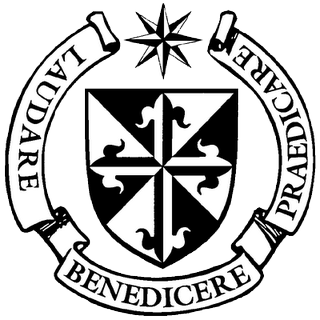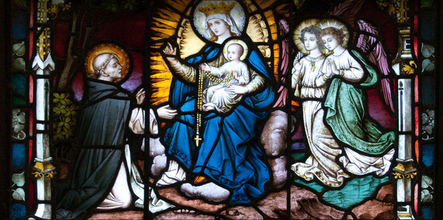The Province of Our Lady of the Rosary was founded to preach the Gospel in the Philippines, in China, and the rest of the nations of the Far East.
It was the first Bishop of Manila Msgr. Domingo de Salazar, O.P., who contributed effectively to the foundation of the said Province. This Dominican priest was nominated by Philip II, King of All Spain, to Pope Gregory XIII as the first Bishop of the Philippines in 1578. Two years earlier Fray Domingo had returned to Spain from Mexico. At that time, he immediately began to recruit volunteer friars from the Priories of the Iberian Peninsula for the challenging task of the Evangelization of the Philippines. Of the eighteen religious who took ship with the new Bishop, leaving Spain for Mexico on July 10, 1580, seven died on the passage between Spain and the New World, as victims of a pestiferous illness which infested the ship they had boarded, and others died after arrival in Mexico. Some of the survivors opted to remain in Hispanola (Santo Domingo) and others to stay in Mexico. However, Bishop Domingo de Salazar, accompanied by Cristobal de Salvatierra, arrived at last in Manila on September 17, 1581.
Before leaving Mexico on his way to the Philippines, Bishop Domingo de Salazar handed over to Fray Juan Crisostomo the task of accomplishing what was involved in the project of founding the new Province. When Fray Crisostomo returned to Spain in 1581, he obtained from the Council of the Indies the permission needed for taking twelve religious to the Philippines, dated March 31, 1582. A few months later, on July 14, the Master of the Order, Fray Paolo Constable de Ferrara, gave his approval for the foundation of the new Province, naming Fray Crisostomo as its Vicar General with all the prerogatives of a Provincial. Furthermore, the Master authorized the Vicar General to take with him some forty religious of our Provinces in Spain and ten more from Mexico and Chiapas (which included what is now part of Guatemala). Shortly afterward, on September 17, 1582, the Master of the Order passed away from earthly life. At this point Pope Gregory XIII intervened, confirming Fray Crisostomo in office as Vicar General and giving his Apostolic Approval for the foundation of the new Province. This was proclaimed on October 20, 1582.
As things turned out, Fray Crisostomo was not able to take ship with his first band of religious as soon as he had thought to do so. Difficulties in Madrid blocked his plans. After two years of waiting in the Convent of San Pablo in Seville, he finally received the Royal Pass on August 9, 1585, granting him the needed permission to gather some Friars and to accompany them to the Philippines, including fifteen more from America. After several months, forty religious, proceeding from various Priories in Spain, left and headed for Mexico on July 17, 1586. Later, Fray Crisostomo resigned as vicar general and handed over his office to Fray Juan de Castro, who became the leader of the first expedition.
When the group had arrived in New Spain (Mexico), the new Vicar General, Fray Juan de Castro, in union with several of the religious, prepared, presented, and signed the Primordial Ordinances of the Province at the Priory of Santo Domingo in Mexico City on December 17, 1586. Those who were not present at this act later approved of it on January 17, 1587. Of the forty religious who took ship from Cádiz, according to the official list preserved in the Archives of the Indies, many fell ill in the course of the sea voyage, and three died in Mexico City because of their sufferings and deprivations during the long crossing. Some stayed in Mexico City, and others returned to Spain. Finally, three friars left for Macau on April 3, 1587, and fifteen others left for Manila on April 6. This last group reached the port of Cavite in the Philippines near Manila on July 22, 1587, and arrived three days later, on July 25, to the City of Manila.
On August 4 of that same year, the Feast of Santo Domingo was celebrated publicly for the first time, and, the next day, the cornerstone of the future Priory of Santo Domingo in Manila was laid on the Feast of the Assumption of the Blessed Virgin.
The new Province, with God’s blessing and as an outcome of strict regular observance, grew rapidly in its various ministries as well as the number of religious in its ranks. In 1592, the conditions had been met for recognition of the group as a Province in the Order. For this reason, the General Chapter of Venice of that year recognized the new Province of the Order under the title of Our Lady of the Rosary for the Conversion of Unbelievers.
Nonetheless, due to an error or oversight, the Decree of Erection and Establishment of the Province of Our Lady of the Rosary did not appear in the Acts of the General Chapter mentioned. The letter of the Master General, Fray Hipolito Maria Becarria, dated November 3rd, 1592, as sent to our Province, clearly states what took place. In the said letter, the Master General bears witness that in the General Chapter of Venice, the new Province was officially erected and instituted as a Province within the Dominican Order with the name of Our Lady of the Rosary. Later on, the said Decree of Erection, previously omitted, appeared in the Acts of the following General Chapter, celebrated in Valencia in 1596.
Denunciamus, quod in capitulo generali Veneto anno domini 1592 in provinciam erecta fuit congregation nostrorum fratrum, qui in insulis Philippinis commorantur pro infidelium conversione, sub titulo beatissimae Virginis de Rosario, etsi postmodum in eiusdem capituli actis tale decretum registratum non fuerit. (Acta Capitulo Generalis Valentiae 1596, cf. Acta Capitulorum Generalium Ordinis Praedicatorum, Vol. V ab anno 1558 usque ad annum 1600, iussu, Reverendisimi Padris Fr. Andraeae Fruhwirth, Romae, Ex Typographia Poliglotta S. S. de Propaganda Fidae, 1901, pag. 364)
The Friars of the Province have evangelized in the Philippine Islands since 1587; in Japan from 1602 until 1637, and again, since 1904; in Taiwan (Formosa) from 1626 to 1642 and since 1858; in Tonkin (Vietnam) from 1676 to 1955; in Venezuela from 1902 to 1905 and from 1951; in South Korea from 1989; in Singapore from 2001; in Myanmar (Burma) from 2010; in East Timor from 2013; and also in Peru, Sri Lanka (Ceylon) and other countries for short periods of time.
From the first days of the Province of Our Lady of the Rosary, new missionaries, nearly all from the Spanish Provinces, were arriving periodically to incorporate themselves into the Province and its ministries in the Far East. Furthermore, neither were lacking vocations, which came forward from the countries where the Province developed its apostolate. Among these, we encounter Mgr. Gregorio Lo, O.P., the first Chinese bishop.
Since the XIX century, the Province has relied on its own formation centers for future missionaries: in Ocana (1830), Avila (1876), Rosaryville-USA (1911-1935), Hong Kong (1935-1962), Manila (1962-1971), La Mejorada (1912), Santa Maria la Real de Nieva (1939), Valladolid (1953), Madrid (1958), Rome (1989), South Korea (1994), Hong Kong-Macau (2005), Myanmar (2010), East Timor (2013), as well as other apostolic ministries in Spain and in Rome.
Finally, as a fruit of the missionary dynamics and the fervent apostolic work of the Province of Our Lady of the Rosary, two new Provinces have arisen in the Order: that of Our Lady Queen of Martyrs in Vietnam, on March 18, 1967, and the Province of the Philippines on December 8, 1971. In like manner, a Vicariate General for our Chinese brethren who live in Taiwan was established on June 16, 1978, under the patronage of Our Lady Queen of China.
In 1987, the Province commemorated the Fourth Centenary of its foundation. The many events celebrated on this occasion were crowned by the Canonizations of sixteen Martyrs of Nagasaki on October 18, 1987, of sixty Martyrs in Vietnam on June 19, 1988, and of six Martyrs of China on October 1, 2000, by Pope Saint John Paul II in Rome. Pope Benedict XVI beatified 21 Martyrs of the 20th Century of Spain, on October 28, 2007.

